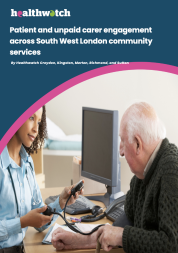Improving emotional wellbeing for young people in 2016
The Youth Councils and local Healthwatch of Kingston and Richmond surveyed young people to get an understanding of their emotional wellbeing and mental health, their experiences of services and their views on how to improve care to meet their needs.
We received 1580 unique and usable responses from people at 51 schools across Kingston and Richmond. The following recommendations were made, based on our findings.
Summary of recommendations
1. Address stigma
Set up a campaign to combat the stigma attached to mental health problems, with a clear message that it is perfectly acceptable to talk about a mental health issue as it is with a physical problem and that no issue is too small to talk about. This would help overcome young people’s fear about being judged negatively if friends, families or school mates and teachers found out that they looked for help about mental health problems.
2. Make support accessible in the community
The majority of young people told us that services should be located out of school in an easily accessible area, a safe environment and delivered in total confidentiality. Libraries, community centres or youth clubs and certainly not in a medical environment or anywhere looks “like something to help mentally ill people”. Support should be available all the time or at least before and after school hours and staffed not only by supportive therapists but also by young people who have overcome emotional issues. A range of ages, genders, sexualities, and race would be good
3. Change the way mental health support is delivered
Services should be delivered in a more informal way, avoiding any approach that “makes you feel nervous”. Include lots of fun activities in groups and one-to-one and enable young people to talk without being judged
4. Encourage young people’s feedback on their counselling experience
Some young people “did not get on” or could not “connect” with counsellors who provided generalised advice, rather than focusing on their specific problems. This should be addressed in order to avoid young people dropping out of therapy. Their expectations of the counselling session, what outcomes to look for, and what input is required should be discussed in advance. There should also be an easy mechanism for young people to feedback their experience anonymously and monitoring of any necessary improvements.
5. Provide an online interactive counselling service
Young people reported that support should be available through online counselling, websites and chat rooms, all regarded as a safe and confidential environment where they can discuss their issues anonymously
6. Promote services currently available
A promotional campaign should be mounted to highlight the benefits of counselling and other services currently available. Young people suggested using Facebook, Instagram and other online tools. Leaflets should also be available in schools and meeting points for young people.
7. Address CAMHS threshold and long waiting list
The issues of long time delay between the initial assessment and the treatment received and the waiting list should be addressed as they resulted in a negative experience and judgement of the support currently available. It is important to review the criteria for CAMHS services and/or provide support for those in need of care but who do not meet the criteria
8. Target support to those who need care most
Women, transgender people, people identifying as LGBO and people from White Other backgrounds report higher levels of need than other groups but are less likely to get care that helps. People from these groups should be prioritised in terms of service development and in terms of promoting existing services.

